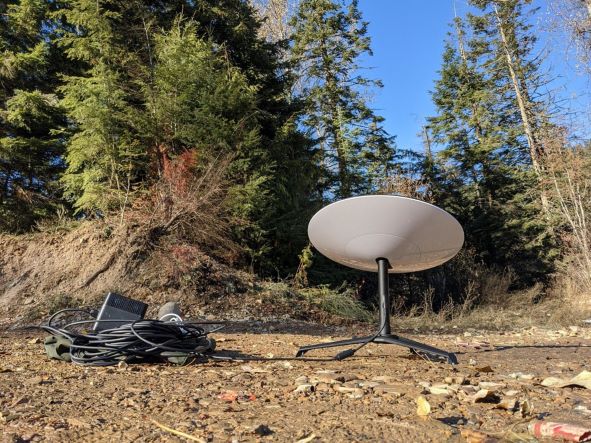Everything You Need to Know About Starlink Internet
Starlink, also known as Space Internet, is a satellite constellation being constructed by SpaceX providing satellite Internet access. The constellation will consist of thousands of mass-produced small satellites in low Earth orbit (LEO), working in combination with ground transceivers. SpaceX also plans to sell some of the capacity on its satellites to commercial customers, including Internet service providers. The system is designed to provide high-bandwidth, low-latency Internet to small terminals around the world.
The first two prototype satellites, Microsat-2a and -2b, were launched on a Falcon 9 rocket on February 22, 2018. As of May 2020, there are over 600 Starlink satellites in orbit. The goal is to have 42 × 10^12 bits/second (420 tbps) of aggregate bandwidth by 2025. SpaceX applied for approval from the United States Federal Communications Commission (FCC) for up to 30,000 Starlink terminals in November 2019.
Starlink in 2022
In 2022, SpaceX plans to have a constellation of 42,000 satellites in low earth orbit to provide high-speed internet to users around the world. The system, known as Starlink, is designed to provide internet speeds of up to 1 Gbps, with latency of less than 20 milliseconds. While Starlink has yet to achieve these speeds, they’ve gotten close with about 500 mbps business class internet. In the future, as more satellite roll out, you can expect Starlink coverage to improve alongside speeds.
How to Sign up for Starlink

To sign up for Starlink, visit the website and create an account. Once you have an account, you can order your Starlink kit. The kit will include everything you need to get started, including the satellite dish, router, and cables. Once you have your kit, follow the instructions to set it up. You will need to point the satellite dish towards the sky and connect it to the router. Once you are connected, you will be able to access the internet through the Star
How to Install Starlink

While some small details may differ, the install process across the board is very simple. Whether you have RV, business, or home, you will receive similar equipment and the installation instructions.
For RVs and other vehicles, here is a step-by-step guide on how to install Starlink:
- Visit the Starlink website and create an account.
- Download the Starlink app on your mobile device.
- Connect your mobile device to your car’s OBD-II port.
- Start your vehicle and open the Starlink app.
- Follow the prompts in the app to complete the installation.
Installation is relatively simple and can be done without any power tools or drilling. There are also optional add-ons for things like RV rooftop installation. You can find lots of resources and directions from Starlink or others online for setting up your Starlink internet serivce.
Starlink Internet Tiers and Pricing
|
Starlink Service |
One-time Equipment Payment |
Monthly Service Cost |
Max Network Speeds |
|
Residential |
$599 |
$135 |
200 mbps down / 20 mbps up |
|
RV |
$599 |
$135 |
100 mbps down / 10 mbps up |
|
Business |
$2,500 |
$500 |
500 mbps down / 40 mbps up |
|
Maritime |
$10,000 |
$5,000 |
350 mbps / 40 mbps up |
Starlink Internet speeds will differ greatly depending on a number of factors. If you are in a low-capacity area, then you may experience slower speeds but less of a difference in speeds throughout the day. High-capacity areas are often more populated so while you may get faster speeds, you may experience more intense slow-downs during peak hours.
There are no guarantees that you will achieve the maximum speeds advertised. Other factors like weather conditions can also have an impact on performance. However, many users and reviewers report much faster speeds on Starlink compared to their competitors. If you are planning on Starlink for RVs, then check out this detailed article on the service: Starlink for RVs
Is Starlink Right for You?
If you’re thinking Starlink may be right for you, then consider some important factors before purchasing. For example, if you have access to high-speed internet via coaxial or Ethernet connections, then you do not need Starlink. The best uses for Starlink will be in areas that do not have easy wired access and weak data reception. Even if you have mobile data, you may prefer a connection that isn’t limited to a couple gigabytes of data.
People who camp, RVers, and people in areas without high-speed internet can all benefit from Starlink. The service is both affordable and flexible. Residential and RV services both cost a monthly fee of $135. While a bit expensive, this would be the only recurring fee you have. Equipment costs are a one time charge. You can also pause your service to avoid paying for months when you may not be using Starlink.
The Future of Starlink Internet
After years of development and testing, SpaceX’s Starlink constellation is finally operational. With over 4,000 satellites in orbit, Starlink is providing low-latency, high-speed internet to remote and underserved areas around the globe. But what does the future hold for Starlink?
SpaceX is planning to add more satellites to the constellation in the coming years, with the ultimate goal of having about 12,000 satellites in orbit. This would allow Starlink to provide coverage to nearly anywhere. There are also potential plans for up to 42,000 Starlink satellites.
SpaceX is also working on ways to improve the system, including better antennas and lasers that would allow data rates of up to 1Gbps. This would make Starlink capable of competing with traditional broadband providers.
In the longer term, SpaceX plans to use Starlink to provide internet to Mars. This would involve launching a dedicated fleet of satellites to orbit the red planet.
Ultimately, SpaceX wants to use Starlink to connect the entire solar system, providing high-speed internet to all corners of the planet. One thing is for sure, Starlink is constantly improving and adding to their constellation of satellites.
